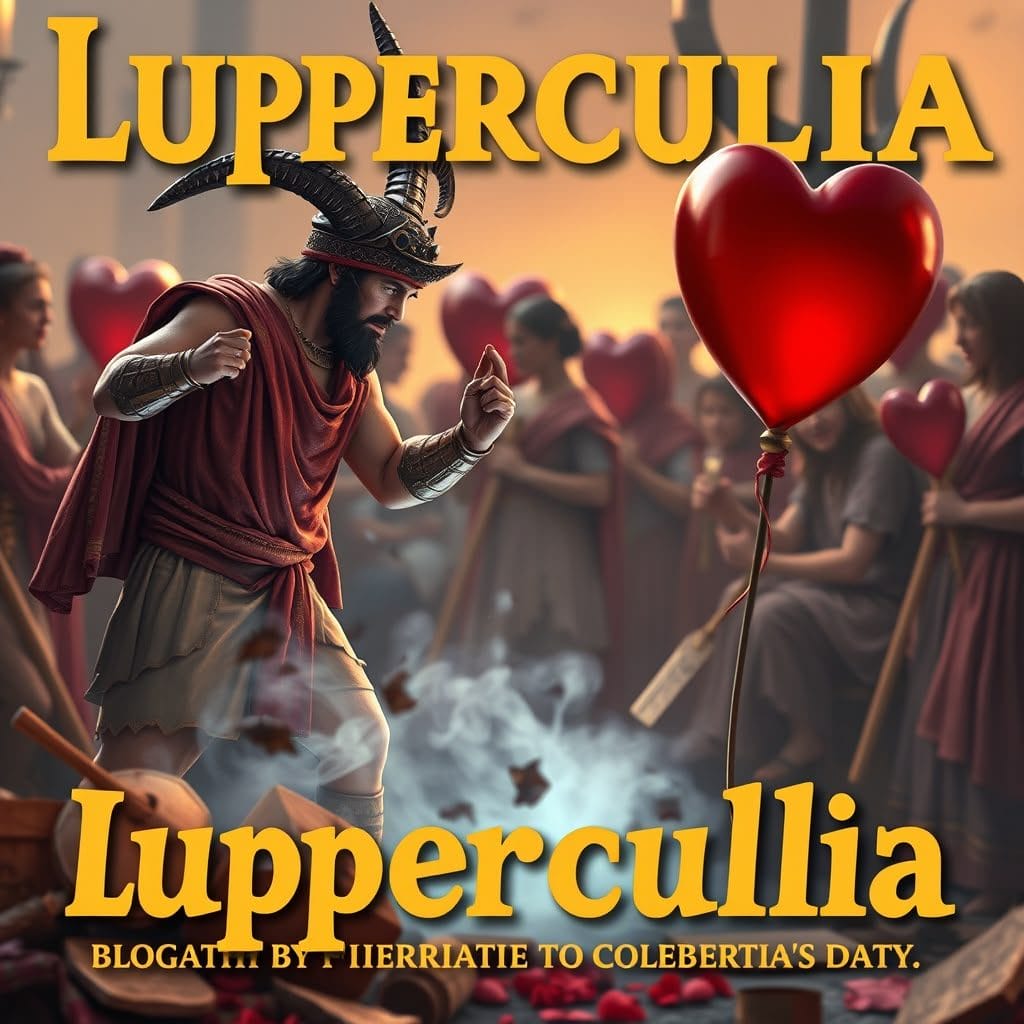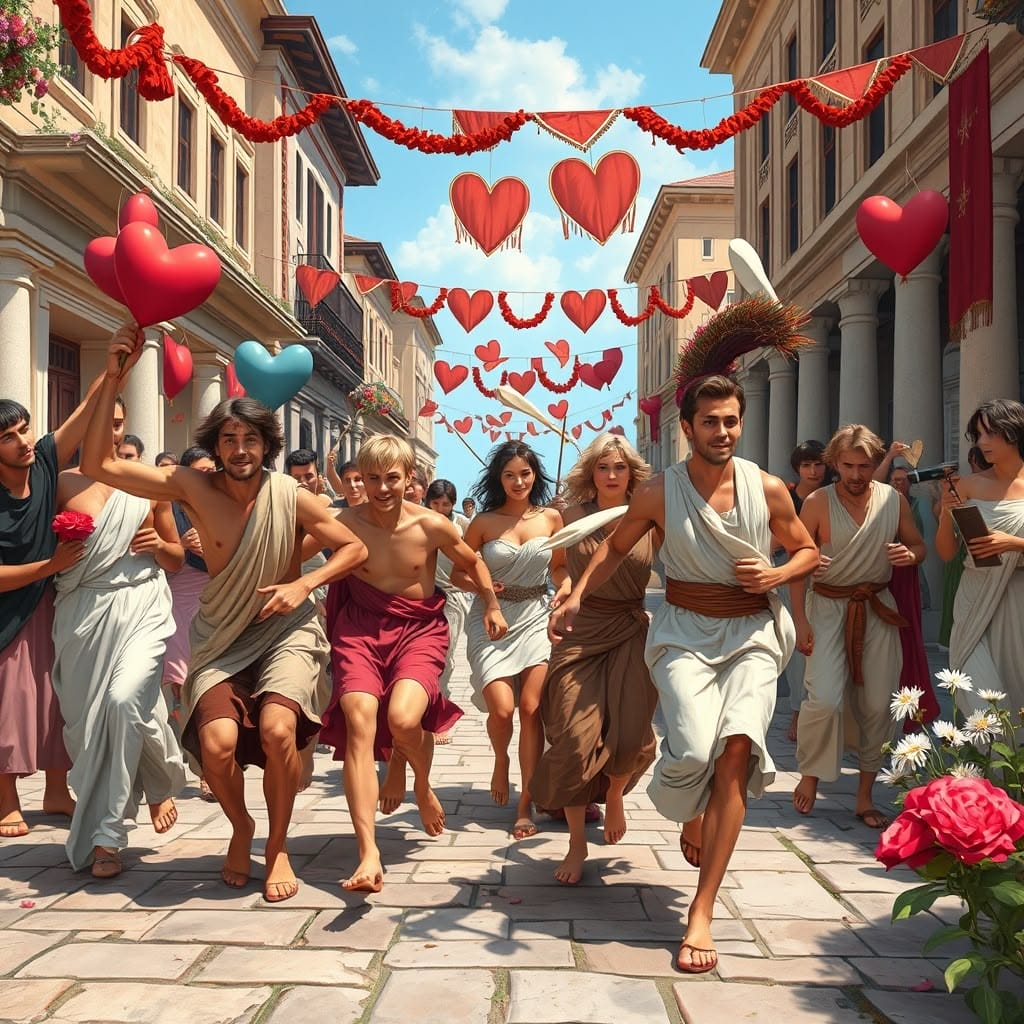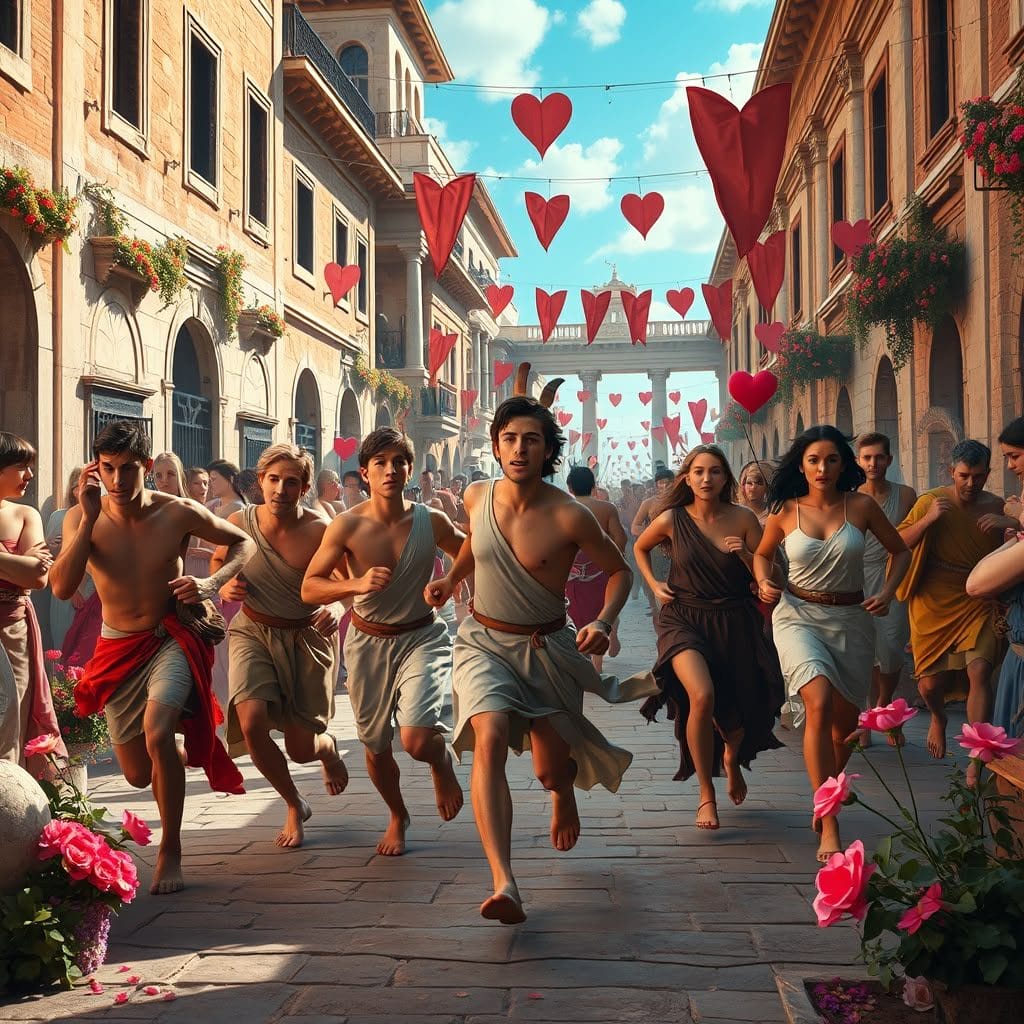Lupercalia: From Fertility Ritual to Valentine’s Day. This ancient Roman festival, celebrated every February 15, has origins that date back to the 6th century BC. Lupercalia honored the she-wolf who nurtured Romulus and Remus, the legendary founders of Rome, while also paying homage to Lupercus, the god of fertility.
The festival was marked by several visceral and engaging rituals, which included:
- Animal Sacrifices: Priests known as Luperci would sacrifice goats and dogs.
- Blood Smearing: Participants smeared blood on their foreheads before cleansing themselves with milk-soaked wool.
- Fertility Whipping: Strips of goat hide, called februa, were used to whip women in hopes of enhancing their fertility.
- Pairing Ceremony: Men drew names from jars to pair with women for the duration of the festivities, often leading to marriages.
The connection between Lupercalia and modern Valentine’s Day lies in the transformation of these ancient practices into contemporary celebrations of love. As early as the 5th century AD, Pope Gelasius I sought to replace Lupercalia with a Christian holiday centered on romance and affection. Elements from Lupercalia likely influenced these new traditions, intertwining themes of love and passion that resonate even today.

This article will explore:
- The origins and rituals associated with Lupercalia
- The transition from this ancient festival to St. Valentine’s Day
- The enduring legacy of Lupercalia in modern culture
By delving into these aspects, you will gain a deeper understanding of how ancient customs shaped today’s celebrations surrounding love and fertility.

Understanding Lupercalia: Its Origins and Rituals
Lupercalia, an ancient Roman festival celebrated annually on February 15, has roots tracing back to the 6th century BC. This vibrant festival honored fertility and the foundational myth of Rome, celebrating the legendary twins Romulus and Remus.

The Significance of Romulus and Remus
Romulus and Remus hold a prominent place in Roman mythology, symbolizing the city’s origins. According to legend, these twins were abandoned at birth and suckled by a she-wolf in a cave known as the Lupercal. This nurturing relationship with the she-wolf became a central theme in Lupercalia, reinforcing ideas of fertility and survival.
The Role of the She-Wolf
The she-wolf represents not only the nurturing aspect but also the wildness associated with nature’s fertility. During Lupercalia, her image served as a reminder of primal instincts and the connection between humanity and nature. The festival’s rituals aimed to invoke her spirit, seeking blessings for fertility in crops, livestock, and human relationships.

Rituals Associated with Lupercalia
Lupercalia was marked by several distinct rituals that reflected its themes of fertility and renewal:
- Animal Sacrifices: Priests known as Luperci performed sacrifices at the Lupercal cave on Palatine Hill. They would sacrifice a male goat and a dog to honor the gods associated with fertility. The blood from these animals played a significant role in subsequent rituals.
- Blood Smearing: After the sacrifices, priests smeared blood on their foreheads. This act was then followed by purification using milk-soaked wool. It symbolized both a physical cleansing and a spiritual renewal for participants.
- Use of Februa: Strips of goat hide known as februa were cut from the sacrificed goat. These strips served multiple purposes during the festival—primarily as tools for whipping women. This ritual aimed to promote fertility among women who desired children.
- Pairing Ceremony: One of the most intriguing aspects of Lupercalia involved pairing men and women for the duration of the festival. Men would draw names from jars containing slips with women’s names written on them. This practice not only encouraged romantic pairings but often led to marriages that lasted beyond the festivities.
The Running Through Streets
Another striking feature was the running of young men through city streets, where they would whip bystanders with februa strips. This act was believed to foster fertility among women who were touched during this procession. The energetic atmosphere mixed excitement with an underlying sense of reverence for fertility rites.

Cultural Significance
Lupercalia wasn’t just about individual rituals; it encapsulated broader cultural values in ancient Rome that emphasized fertility, family, and community ties. As participants engaged in these lively ceremonies, they reinforced social bonds while appealing to divine powers for prosperity.
The practices surrounding Lupercalia reveal much about Roman society’s beliefs regarding love, reproduction, and celebration. By looking into these ancient customs, you can appreciate how they laid foundational elements that would eventually evolve into more contemporary celebrations surrounding love and romance.
This exploration highlights how deeply rooted traditions can shape future holidays like Valentine’s Day while still holding echoes of their original meanings within societal structures.

From Lupercalia to St. Valentine’s Day: The Evolution of Love Celebrations
The transformation from Lupercalia to St. Valentine’s Day in the 5th century AD illustrates a significant cultural shift. This transition marks the Christianization of ancient pagan practices, reflecting how early Christians assimilated and recontextualized festivals to align with their beliefs.
The Role of Pope Gelasius I
Pope Gelasius I played a pivotal role in this transformation. In an effort to diminish the influence of pagan traditions, he sought to replace Lupercalia with a Christian holiday celebrating love and devotion. His decree established February 14 as St. Valentine’s Day, honoring the martyrdom of Saint Valentine, who is often associated with romantic love.
Significance of Saint Valentine
The life of Saint Valentine is steeped in various legends, one being that he performed secret marriages for couples defying Emperor Claudius II’s ban on marriage for young men. This act symbolizes love and commitment, aligning well with the spirit of Lupercalia but devoid of its more violent rituals.

Christianization of Festivals
The adaptation of Lupercalia into St. Valentine’s Day is part of broader patterns seen throughout history, where early Christians repurposed pagan celebrations:
- Cultural Integration: By integrating elements from existing festivals, Christianity made its teachings more relatable to converts accustomed to these traditions.
- Celebration of Fertility and Love: While Lupercalia focused on fertility through ritualistic practices like striking women with goat hide strips (februa), St. Valentine’s Day shifted towards honoring romantic love without the aggressive undertones.

Elements Influencing Modern Celebrations
Lupercalia’s influence can still be traced in contemporary Valentine’s Day celebrations. Various customs and symbols have evolved from these ancient practices:
- Symbols of Love: Red roses, chocolates, and heartfelt messages reflect themes rooted in both Lupercalia and St. Valentine’s legacy.
- Celebratory Rituals: The exchange of cards and gifts mirrors older customs where couples were paired during Lupercalia festivities.
A Closer Look at Rituals
During Lupercalia, couples were randomly paired by drawing names from jars—an aspect that laid groundwork for the romantic gestures we see today. This practice illustrated a communal approach to love that resonates even now in modern matchmaking events or dating apps.
The evolution from Lupercalia into St. Valentine’s Day showcases how traditions can adapt over time while retaining echoes of their origins. Understanding this transition enriches our appreciation for contemporary love celebrations and highlights how historical practices continue to shape modern expressions of affection.

The Enduring Legacy of Lupercalia in Modern Culture
Lupercalia continues to have an impact on modern culture, influencing various aspects of contemporary life. The festival’s themes of fertility, love, and renewal can be seen in many ways, especially in literature and art.
Cultural Significance Today
The main elements of Lupercalia are still relevant in modern celebrations. Many customs associated with Valentine’s Day can be traced back to the ancient festival, including some controversial aspects that reflect a darker side of love. These connections show how cultural practices change over time while still keeping their fundamental symbols of love and fertility.
- Fertility and Love: Modern relationships often celebrate themes reminiscent of Lupercalia. The pursuit of love, romantic gestures, and expressions of affection are evident during Valentine’s Day. The concept of pairing couples through chance—similar to the name-drawing practice from Lupercalia—persists in various matchmaking events today.
- Rituals and Symbols: Colors associated with Valentine’s Day, such as those discussed in this article on the colors of Valentine’s Day, symbolize passion and purity, mirroring the duality found in Lupercalia’s focus on procreation and renewal. This symbolic connection serves as a reminder of humanity’s enduring desire to celebrate love.

Legacy in Literature and Art
Lupercalia’s vibrant imagery has inspired countless works in literature and art over centuries. Its influence can be seen across different mediums:
- Literature: Classic authors like Shakespeare referenced themes related to love and fertility that align closely with those celebrated during Lupercalia. In Romeo and Juliet, for instance, the passionate romance encapsulates the fervor associated with springtime fertility rituals. Modern novels often explore similar themes of love transcending societal boundaries, echoing the spirit of Lupercalia.
- Art: Artists throughout history have depicted themes from Lupercalia through visual representation. From paintings capturing the essence of springtime rebirth to sculptures illustrating the she-wolf nurturing Romulus and Remus, these works reflect an appreciation for ancient traditions. Contemporary artists frequently integrate concepts inspired by Lupercalia into their pieces, emphasizing emotional connections between individuals.

Themes Persisting Today
As society evolves, remnants of Lupercalia remain embedded in cultural practices:
- Celebratory Events: Festivals held around February continue to embrace themes of love and fertility. Events often incorporate rituals that pay homage to ancient customs, reflecting society’s desire for connection.
- Modern Interpretations: Contemporary interpretations might involve playful activities akin to ancient rites. For example, couples partake in games or challenges designed to strengthen bonds while celebrating their relationships’ joyous aspects.
- Cinematic Representation: Films frequently explore love stories that tap into universal themes present since antiquity. These narratives resonate deeply with audiences, showcasing the undying quest for companionship—a sentiment central to both Lupercalia and modern romantic celebrations.
Connecting past traditions with current practices highlights how Lupercalia has influenced societal views on love over time. Each February brings a renewed opportunity for reflection on these enduring legacies as individuals engage with their own cultural narratives surrounding romance and connection.

Conclusion
Lupercalia’s significance extends beyond its ancient roots, deeply influencing contemporary celebrations of love and fertility. Its legacy is evident through various aspects of modern culture, particularly in how we commemorate relationships today. The festival’s themes resonate in the following ways:
- Ritualistic Elements: The animal sacrifices and fertility rites reflect a cultural narrative that celebrates life’s cycles. Such practices have transformed but still echo in today’s traditions.
- Valentine’s Day Connection: This transition from a pagan festival to a Christian observance underlines the importance of historical context in understanding our present-day celebrations.
The evolution of love celebrations holds lessons about societal values and beliefs throughout history. Lupercalia, with its wild festivities, speaks to the primal connections humans have with fertility and love. As these elements melded into St. Valentine’s Day, it created a rich tapestry that informs our understanding of romance.
Encouragement exists for readers to explore their own cultural traditions critically. Recognizing how past practices shape current norms provides insight into personal and collective identities. Is there a ritual or celebration in your culture that reflects historical shifts? Engaging with these traditions can enhance appreciation for the complexity of human expression.
Reflecting on Lupercalia: From Fertility Ritual to Valentine’s Day reveals much about how societies evolve yet retain threads from their past. As you celebrate love and connection this February, consider the deeper meanings behind your traditions and how they have been shaped over centuries by festivals like Lupercalia.

FAQs (Frequently Asked Questions)
What is Lupercalia?
Lupercalia is an ancient Roman festival held every February to celebrate fertility and the founding of Rome. It involves various rituals, including animal sacrifices and the running of young men through the streets, where they would strike women with strips of goat hide to promote fertility.
How did Lupercalia influence Valentine’s Day?
Elements of Lupercalia have influenced modern celebrations like Valentine’s Day, particularly in themes of love and fertility. The transition from Lupercalia to St. Valentine’s Day occurred in the 5th century AD, largely due to the efforts of Pope Gelasius I in Christianizing pagan festivals.
What rituals were performed during Lupercalia?
Rituals during Lupercalia included animal sacrifices, blood smearing, and the use of februa, which are strips of goat hide. These practices were believed to promote fertility and were integral to the celebration.
What is the significance of Romulus and Remus in relation to Lupercalia?
Romulus and Remus are central figures in Roman mythology as the legendary founders of Rome. Their story is closely tied to Lupercalia, which celebrates not only fertility but also the origins of Rome itself.
How is Lupercalia represented in modern culture?
Lupercalia’s themes persist in modern culture through its representation in literature and art. The festival’s emphasis on fertility and love continues to echo in contemporary celebrations, reflecting its enduring legacy.
Why is it important to understand the historical context of festivals like Lupercalia?
Understanding the historical context of festivals like Lupercalia allows us to appreciate their evolution over time and how they shape contemporary celebrations. It encourages a critical exploration of our cultural traditions and their meanings.

